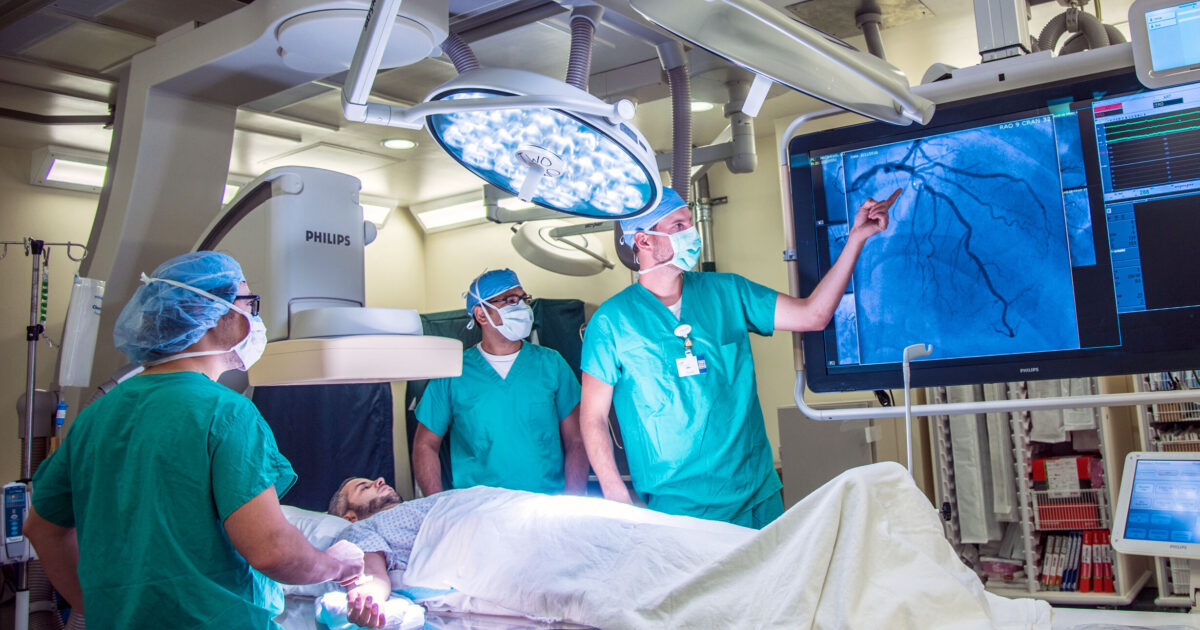Cardiology Jupiter: Facts vs fiction
Cardiology Jupiter: Facts vs fiction
Blog Article
Understanding the Value of Cardiology in Modern Health Care Providers
Cardiology plays a vital role in modern-day medical care, particularly as cardiovascular disease proceeds to be the leading root cause of mortality worldwide. Advances in diagnostics and therapy have actually changed client treatment, allowing earlier treatments and enhanced results. Additionally, the shift towards preventive cardiology encourages people to handle their health and wellness proactively. As modern technology remains to progress, the integration of ingenious services may better redefine cardiology's effect on public wellness, prompting a closer evaluation of emerging patterns and their implications.
The Frequency of Heart Problem and Its Effect on Public Health
Heart illness remains the leading cause of death worldwide, its impact extends far beyond individual people to affect public health systems and economic climates. The high prevalence of heart condition positions a substantial stress on healthcare resources, requiring raised financing for prevention, recovery, and treatment programs. Public health initiatives should deal with threat factors such as obesity, smoking, and less active lifestyles, which add considerably to the increasing incidence of heart conditions.Moreover, the economic worry connected with heart problem is tremendous, encompassing not only straight clinical expenses however likewise indirect expenditures connected to lost productivity and premature death. Areas deal with difficulties in taking care of these prices, frequently bring about variations in healthcare accessibility and outcomes. As the population ages and lifestyle-related dangers proceed to escalate, the urgency for effective cardiology treatments becomes vital. Addressing heart condition is not only an issue of specific health and wellness but additionally an essential public health and wellness priority.
Developments in Cardiac Diagnostics and Imaging Techniques
Current innovations in cardiac diagnostics and imaging techniques have changed the area of cardiology, enhancing the ability to find and keep track of heart conditions. Techniques such as heart MRI, CT angiography, and echocardiography have become progressively advanced, supplying thorough pictures of cardiac frameworks and features. These techniques enable the very early recognition of problems like coronary artery condition, cardiac arrest, and valvular disorders.Moreover, advancements in non-invasive diagnostics, such as wearable innovation and remote monitoring gadgets, have actually equipped patients and doctor. These tools assist in real-time tracking of heart rhythms and other crucial signs, bring about timely interventions. Additionally, expert system is being incorporated right into imaging analysis, enhancing precision and performance in medical diagnosis.
Technologies in Treatment Choices for Heart Issues
Current advancements in cardiology have actually caused substantial innovations in therapy alternatives for heart disease. These include sophisticated medical techniques that improve step-by-step outcomes and arising medications that use new methods for treatment. As the area develops, these advancements play a vital function in enhancing patient treatment and end results.
Advanced Surgical Techniques
Advancements in medical techniques have actually transformed the landscape of cardiology, supplying new wish for patients with heart conditions. Minimally intrusive treatments, such as catheter-based interventions, have greatly reduced recuperation times and medical facility remains. Methods like robotic-assisted surgery improve accuracy, permitting cosmetic surgeons to navigate intricate anatomical structures with higher accuracy. Additionally, improvements in imaging innovation promote real-time visualization during procedures, enhancing results. Transcatheter aortic valve replacement (TAVR) exemplifies a development in treating aortic constriction, allowing shutoff replacement without open-heart surgery. In addition, hybrid techniques that integrate catheter-based and medical techniques supply customized remedies for various heart concerns. These innovative medical strategies not just improve person safety but also expand therapy alternatives, underscoring the crucial function of innovation in modern-day cardiology techniques.
Emerging Treatments and medications
As the landscape of cardiology proceeds to develop, arising medicines and treatments play a pivotal duty in improving treatment options for heart problems. Developments such as novel anticoagulants and advanced lipid-lowering agents have transformed the administration of cardiovascular diseases, significantly reducing patient morbidity and death. Furthermore, the advancement of gene therapies and regenerative medication offers encouraging opportunities for treating conditions previously regarded irreversible. Clinical trials are constantly exposing the efficiency of these therapies, pushing the boundaries of conventional therapies. In addition, the assimilation of digital health and wellness technologies assists in tailored medication, enabling tailored therapy plans based on genetic and way of living aspects. Jointly, these advancements emphasize the dynamic nature of cardiology, improving person outcomes and redefining standards of care in contemporary healthcare.
The Function of Preventive Cardiology in Client Care
Precautionary cardiology plays a vital function in person treatment by concentrating on the identification of danger elements that contribute to heart disease. Through lifestyle adjustment techniques and early discovery techniques, medical care service providers can properly reduce the incidence of cardio events - Cardiology. This proactive method not just improves individual end results however additionally advertises long-term health and wellness
Danger Variable Recognition
While heart diseases continue to be a leading root cause of morbidity and mortality worldwide, effective risk aspect identification works as a keystone of preventive cardiology. Determining threat elements such as hypertension, family, diabetic issues, and hyperlipidemia background is vital for very early intervention. Medical care professionals use various evaluating techniques to examine these factors, permitting tailored precautionary steps. Furthermore, comprehending an individual's way of life choices, such as smoking cigarettes and physical inactivity, better informs danger assessments. This complete examination enables medical professionals to establish tailored care plans intended at mitigating dangers. By focusing on threat element recognition, health care systems can improve client end results and minimize the general burden of heart diseases, eventually adding to improved public health techniques and resource appropriation.
Way Of Life Modification Techniques
A wide variety of researches highlights the essential role of lifestyle adjustment strategies in reducing cardio condition risk. These strategies encompass nutritional adjustments, raised exercise, smoking cessation, and weight monitoring. By adopting a heart-healthy diet plan abundant in fruits, vegetables, whole grains, and lean healthy proteins, individuals can decrease cholesterol degrees and blood stress. Normal exercise reinforces the heart and improves total cardiovascular wellness. Furthermore, giving up smoking cigarettes significantly decreases the danger of cardiovascular disease and improves recovery prices for those with existing conditions. Weight monitoring additionally adds to cardio wellness by mitigating various other threat aspects such as diabetes and high blood pressure. Carrying out these way of life changes not only advertises private health however additionally functions as a cornerstone of preventative cardiology in patient treatment.
Early Discovery Strategies
Way of life modifications significantly add to lowering cardio illness risks, yet they are most effective when coupled with very early detection methods. Preventive cardiology emphasizes the relevance of determining possible heart concerns prior to they rise into major problems. Methods such as blood stress tracking, cholesterol imp source screening, and advanced imaging innovations like echocardiograms play critical roles in reviewing cardiovascular health and wellness. Biomarkers and hereditary screening likewise boost the accuracy of very early discovery, permitting tailored preventative techniques. Regular cardiac danger examinations equip medical care companies to interfere proactively, possibly stopping cardiac arrest and strokes (Cardiology Jupiter). By incorporating these early detection approaches into routine care, individuals can profit from prompt way of living treatments and targeted therapies, inevitably improving and boosting end results high quality of life
Integrating Innovation Into Cardiology Practices
As advancements in technology continue to reshape numerous fields, the integration of cutting-edge tools and systems right into cardiology practices has actually come to be important for boosting client care and results. Telemedicine platforms allow cardiologists to monitor individuals from another location, improving access to care while minimizing the worry on medical care facilities. Wearable devices, such as smartwatches, make it possible for continual heart rate monitoring, notifying both doctors and clients to prospective issues in real-time. Additionally, synthetic intelligence (AI) is anonymous being used to examine huge quantities of heart information, helping in very early diagnosis and personalized therapy plans. Advanced imaging methods, including 3D echocardiography, boost visualization of heart frameworks, causing extra specific treatments. Electronic health and wellness records (EHRs) streamline patient information management, making sure that cardiologists have immediate accessibility to crucial information. With each other, these technological advancements are changing cardiology, advertising positive administration and improved health and wellness results for clients with cardio conditions.
The Relevance of Person Education and Interaction
Patient education and learning and interaction play a crucial function in the administration of cardio health and wellness. By equipping clients with understanding concerning their problems, therapy options, and way of living adjustments, doctor empower people to take an energetic duty in their treatment. This proactive approach can result in improved adherence to prescribed medications, dietary changes, and exercise regimens, ultimately lowering the risk of complications.Engagement also promotes a solid patient-provider relationship, urging open interaction and count on. When people feel educated and included, they are more most likely to voice worries and ask concerns, which can result in better clinical outcomes. Furthermore, academic resources, such as workshops or digital platforms, can enhance understanding and promote self-management approaches. Overall, prioritizing individual education and learning and engagement is essential for boosting cardiovascular health, enhancing quality of life, and lowering health care expenses connected with heart diseases.
Future Fads in Cardiology and Their Possible Effect

Often Asked Questions
What Way Of Life Adjustments Can Reduce Heart Illness Risk?
The present concern addresses way of living changes that can considerably reduce heart illness danger. Cardiology care. Taking on a well balanced diet, their explanation participating in routine physical activity, keeping a healthy and balanced weight, taking care of anxiety, and preventing tobacco can especially boost cardio health
Exactly How Can I Recognize Early Signs of Heart Issues?
Acknowledging very early signs of heart problems entails surveillance signs such as breast pain, lack of breath, fatigue, and irregular heart beat. Timely awareness of these indicators can motivate required medical analysis and treatment for much better results.
What Are the Differences Between Cardiologists and Heart Surgeons?
The differences between cardiologists and heart specialists depend on their roles; cardiologists largely detect and manage heart conditions with non-invasive methods, while heart doctors carry out surgeries to fix architectural heart issues. Each plays an essential, unique role.

Just how Often Should I Obtain My Heart Health And Wellness Checked?
The frequency of heart medical examination varies based upon individual risk elements. Normally, grownups should go through analyses every one to 2 years, while those with existing conditions may need even more frequent evaluations as suggested by healthcare specialists.
What Duty Does Genes Play in Cardiovascular Disease Risk?
Genetics significantly influences heart disease threat, with domestic patterns indicating inherited problems. Particular genetics can predispose individuals to high blood pressure, cholesterol problems, and various other cardio issues, highlighting the significance of genetic testing in assessing heart health. Heart condition remains the leading reason of fatality around the world, its impact prolongs far past specific patients to influence public health and wellness systems and economic situations. Public health and wellness campaigns have to address danger elements such as weight problems, smoking cigarettes, and sedentary way of livings, which contribute substantially to the increasing incidence of heart conditions.Moreover, the financial burden associated with heart disease is immense, including not only direct medical prices yet additionally indirect expenditures related to lost productivity and early mortality. Preventive cardiology plays an important function in individual care by focusing on the identification of danger aspects that contribute to heart illness. Artificial intelligence (AI) and maker understanding are enhancing diagnostics and person surveillance, enabling early detection of heart diseases. The differences between cardiologists and cardiac cosmetic surgeons lie in their functions; cardiologists mostly detect and handle heart problems with non-invasive techniques, while cardiac cosmetic surgeons carry out surgical procedures to fix structural heart issues.
Report this page